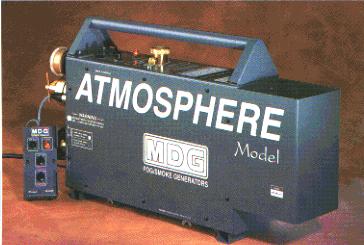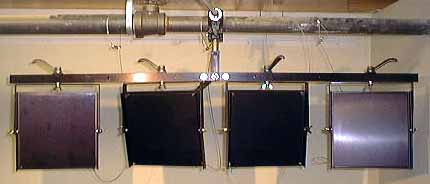|
How
Laser Shows Work - Outboard Equipment
It takes more than the
laser, projector, console and graphics system to present a spectacular
laser show. Laserists need smoke machines, fiber optic beam
delivery systems and other outboard equipment.
Smoke Machines

A "hazer" type smoke machine
that makes very fine particles -
Photo courtesy of MDG
One of the most important pieces of
outboard equipment (for laser beam displays) is the smoke
machine. Since light itself is invisible, the eye only
sees the reflection of light from objects and surfaces,
laserists need to put particulate matter (haze or smoke)
into the air to make the laser beams visible. The fine
particles from the smoke machine deflect the light from
the laser towards your eye so you can see the beam
effects in the air.
The two most common types of smoke machine in use are
"water based" machines and "hazers". Water based
smoke machines use a water based fluid that is pumped through a heated
evaporation chamber. They typically produce dense clouds of large
particles which do not remain suspended in the air for long.
Hazers typically use an oil based fluid that is forced
at very high pressure through a very fine nozzle to "crack" the
fluid into ultra fine droplets. Hazers produce a very fine haze that
is often invisible to the eye but which makes lots of microscopic
particles which remain suspended on the air for a long time and reflect the light
from the laser beams towards your eyes.
Fiber Optics
Laser light shows may make use of
fiber optics to transmit the laser beam from the laser
system to the projector or (more often) from the
projector to a remote scan head. The hair-thin glass fiber acts as a
"pipe" to transmit the light from the input coupler, through
the fiber, to the output colliminator.
'Side Glow' fiber is a thicker type of fiber
optic that has no jacketing surrounding it. The light in the fiber
can escape out the sides so can
also be used as a special effect where hair-thin,
glowing, lines of light are required; such as for product outlines or as
signage.

Coupler, fiber optic and output colliminator
- Photo courtesy of new Method Lasers
Add-on Effects
Laser light shows make use of effects
such as bounce mirrors, mirror balls, spinning
diffraction gratings, remote servo controller mirrors and
other effects to manipulate and re-direct the beams
projected from the laser projector. By using bounce mirrors, the
beams are reflected around the venue creating the illusion that there are
more beams in the space.
|

|
| An array of bounce
mirrors hanging from a pipe (the mirrors are turned away from the
camera as this photo was taken during set-up) |
There are also add-on electronic devices used with
laser systems such as geometric correctors which can remove distortions in
the laser image caused by off-axis
projection or projecting onto onto
uneven surfaces, 360 degree projectors which
allows for the projection of the images at
many points around the venue rather than in
just one location, digital colour decoders, time code
synchronisers to synchronize laser effects to
video, and laser show storage systems.

ADAT-XT recorder
- Photo courtesy of Pangolin
One of the most commonly used add-on devices is the ADAT
recorder. Originally designed as an 8 track digital audio recorder
for small studios, it can be modified to record laser signals. Audio
signals occupy a spectrum from 20 Hz to 20 KHz while laser signals are
from 0 Hz (DC) to about 10 KHz. The CADA-MOD board by Pangolin Laser
Systems conditions the laser signals and modifies the ADAT recorder so
that X, Y, R, G, B, a control signal and left and right audio can be
recoded onto tape. By recording a show on tape, it can be reproduced
exactly the same every time or can be sent to other locations or even
other countries for playback.
[
Laser
and exciter | Projector
| Scanners | Control
console | Graphics system
| Outboard Equipment ]
|